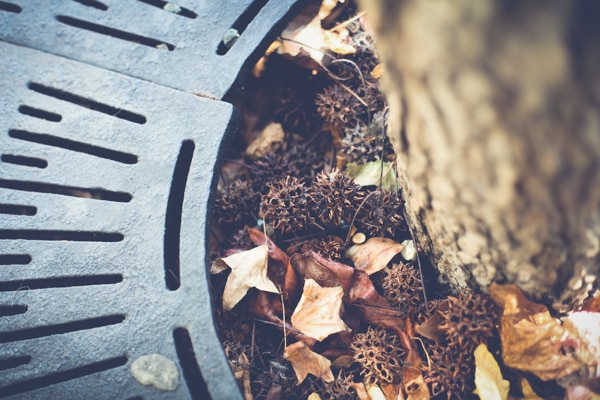


San Diego is a sunny city with a mild climate that supports a wide array of trees. This region’s natural land is composed primarily of low-growing scrubland, so to add more plant life, different tree species were introduced in the last two centuries. Some of these trees have fit in well with their new home, while others have brought on negative consequences that San Diegans generations later have had to deal with. While all trees have their quirks, some species have proven to be a bigger headache than others—making our “San Diego Trees That Many Regret Planting” list.
Liquid Amber
The Deceptive Charmer
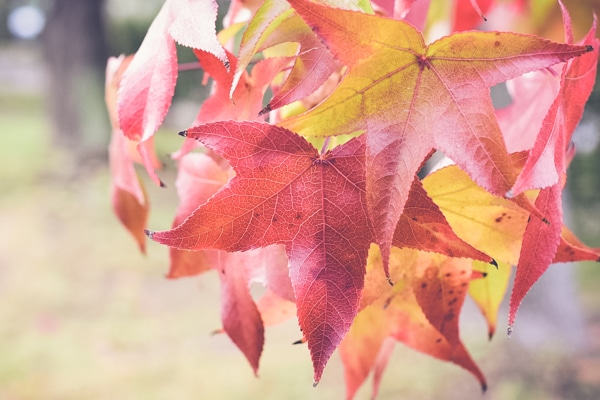

The liquid amber tree, also known as Liquidambar or sweetgum tree, was first introduced to Southern California as a moderate-sized tree known for its vibrant maple-like leaves, as well as its photogenic autumnal display. Originating from the Eastern and Southeastern United States, as well as Mexico and Central America, this species found favor with many people for its lustrous, maple-like leaves that turn a beautiful red late fall through the winter. However, as picturesque as it may be, there are a few issues with this tree that have caused many San Diego locals to wish they had opted for another tree to decorate their landscape.
What issues do Liquid Amber trees have?
Talk about messy! As deciduous trees, liquid ambers require annual leaf clean-ups when they drop their foliage. But faulting a tree its leaf drop is just being too finicky. For people in places like Boston, raking up piles of leaves is just part of normal autumn tasks. However, the liquid amber doesn’t just drop leaves, these trees also rain down an annoying amount of spiky, hard seed pods. Good-looking tree, yes—but this isn’t a tree that you would want to walk around barefooted! Even walking around these with shoes can be problematic. Because these seeds are hard and round, it is not uncommon for people to roll their feet on them and sprain their ankles.
And as you can expect from any sizeable tree, the liquid amber will drop an incessant amount of spiky balls that litter its surroundings. But you can’t blame the tree. These painful seed pods are a part of how the tree was created to survive. What squirrel would want to eat them? Instead, they can be left alone to sink underground to grow into a baby tree.
Eucalyptus Tree
Majestic, yet menacing

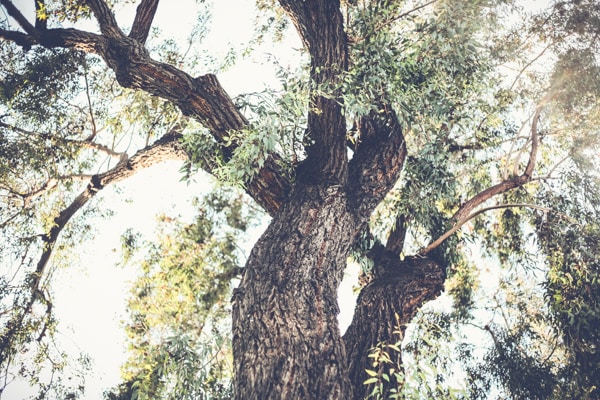
Several eucalyptus tree species are a prevalent sight in San Diego, from our canyons to our residential properties. Originating primarily from Australia, these trees were introduced to California in the late 1700s. But they didn’t explode in numbers until the enactment of the California Tree Culture Act of 1868, which encouraged Californians to plant trees since the region’s natural scrubland terrain is comprised mostly of low-growing shrubs. So in order to populate the terrain with trees, the eucalyptus seemed like the perfect fit. It grew well in arid climates. It grew tall. And it grew fast.
What issues do Eucalyptus trees have?
The aromatic leaves of eucalyptus trees have brought soaring life into California’s scrubland for centuries. However, there’s a dangerous and damaging side to these trees. When storm season strikes San Diego, the eucalyptus trees have been a big concern for locals because of their tendency to fall over.
But in season or out of season, these trees can still be huge hazards! Whether the winds are strong or just barely blowing, the eucalyptus trees are culprits of sudden limb drop—where just as the name implies, a limb suddenly drops without warning. In other tree species, it is typical that a precarious branch can be spotted either because 1) the limb, itself, is already showing signs of stress or early signs of breakage or 2) the tree is unhealthy or stressed. However, with eucalyptus trees, a seemingly healthy branch can fall. As you can imagine, this would not be the ideal tree to sit under for an afternoon picnic.
Another issue that eucalyptus trees impose on San Diego is their invasive characteristic. This tree can thrive in dry conditions, however, given an adequate amount of water, it will dominate an area. This is why they are a common sight closer to the coast or along a stream.
As part of their invasive nature, the eucalyptus has an unfortunate tendency to change the local ecosystem. Once established, they alter the natural soil chemistry, create a greater fire hazard, reduce the available light to other plants nearby, and crowd out our region’s native plant and tree species. In addition, the local bird and insect populations have been affected. While eucalyptus trees attract birds and overwintering monarch butterflies, as they invade native ecosystems, they alter the composition of insect and bird communities that naturally breed in San Diego’s native trees.
Due to the negative impact that eucalyptus trees have had on San Diego, efforts have been made to manage their population and re-establish native oak trees. Many projects are underway to remove tens of thousands of eucalyptus trees, as well as other non-native trees, to reduce the risk of wildfires.
Tree-of-Heaven
Messy and Invasive
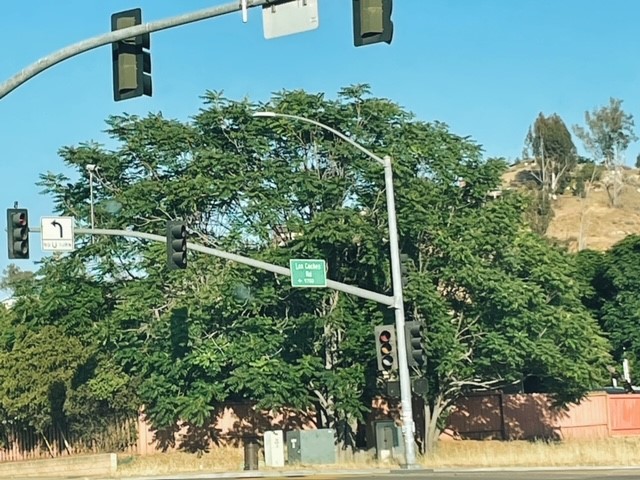
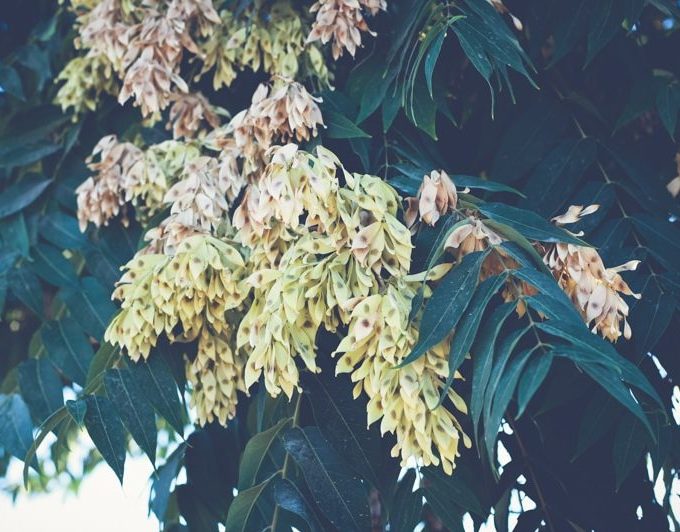
The tree-of-heaven, or Ailanthus altissima, is a deciduous tree native to northeast and central China, as well as Taiwan. It was first introduced to North America in the late 1700s and brought to California during the Gold Rush by Chinese immigrants. Known for its rapid growth in nearly any environment, the tree has become naturalized in 42 of the 50 states. It has an amazing ability to survive in areas with minimum levels of light, moisture, and poor soil conditions.
What issues do tree-of-heaven trees have?
Where should we begin? Don’t let looks deceive you. While the tree-of-heaven may look beautiful in the spring and summer with its bountiful soft-pink blooms and tropical essence—come wintertime, it’s an ugly conglomeration of bare, straggly limbs. And that ugly exterior is just a glimpse of the ugly trouble that this tree brings.
There are so many issues that exist with the tree-of-heaven that all go hand-in-hand. This is a tree that was designed to survive and proliferate. It’s practically a giant weed! But it’s not just a weed that you can simply pull out of the ground and be done with. If not properly and thoroughly removed, it will keep coming back over and over again.
We have yet to find a tree-of-heaven that was intentionally planted because these trees just have a habit of showing up—like an unwelcomed party guest. Then if left to grow and mature, little tree-of-heaven babies start popping up and dominating the area.
The Tree-of-heaven can grow to be a damaging and expensive issue to fix if left to grow on a property.
We recommend that any tree-of-heaven on a property should immediately be removed, and this is the only tree species in San Diego that we say this about. It is invasive. It is damaging. And it will be costly, especially if left to mature and populate an area.
Unfortunately, the removal of the tree-of-heaven is not like a typical tree removal. With every other tree species in our city, a full removal involves a cut-and-drop process, followed by grinding the stump. However, the tree-of-heaven, being extra “special,” requires a potent herbicide to kill its roots. If this process is left out, then the remaining root system will continue to sprout saplings until it is killed.
Brazilian Pepper Tree
A Peppery Beast
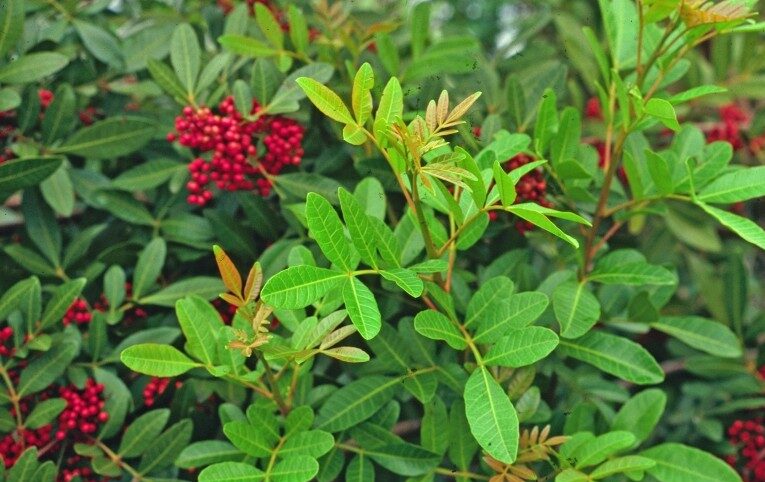
Photo courtesy of Aquaplant.tamu.edu.
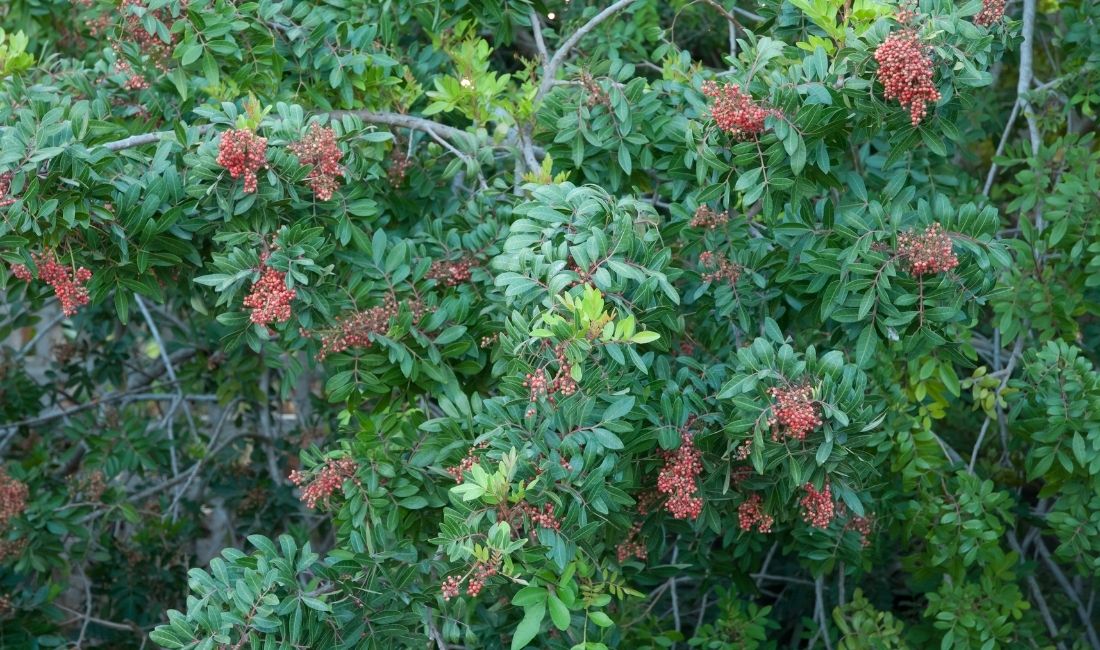
Photo courtesy of Coastal Gardens Pro.
The Brazilian pepper tree, not to be confused with the whispy California pepper tree, is native to Argentina, Paraguay, and Brazilian forests. First brought to California in the late 1800s, the tree is sold as an ornamental evergreen tree. It showcases shiny green foliage and creamy white flowers that give birth to clusters of small, red berries—a feature that has given this tree the nickname Christmasberry tree. However, these berries are toxic to humans and animals.
What issues do Brazilian pepper trees have?
If you are contemplating adding the Brazilian pepper tree to your landscape, please reconsider. Like other trees on this list, this species has a knack for taking over an area and crowding out other plant life, especially those native to San Diego. It even changes the soil chemistry which inhibits the growth of other plants. Therefore, the natural ecosystem is disrupted as organisms that depend on native plants are affected.
While not as troublesome as the tree-of-heaven, the Brazilian pepper tree is the only tree in San Diego that comes close. It has a tenacity for survival and proliferation, which is a trait to be applauded in any plant or animal species, but it is not the best characteristic when one is simply trying to make their property look nice and well-maintained.
The Brazilian pepper tree grows lateral roots underground that shoot out new sprouts throughout the area. This habit then becomes a headache as homeowners tire of removing baby trees. But as with other trees and plants that birth offspring through their lateral roots, this species is a difficult one to remove because it requires an herbicide to fully eradicate it.
If you already have a mature Brazilian pepper tree on your property, then you are most likely well aware of its love of propagating. We recommend that you continue to control its population. If more are allowed to mature, they will also begin to spread lateral roots, and your issue will multiply. If you have a young Brazilian pepper tree, we recommend removing it. And if you were considering planting a Brazilian pepper tree, then stop!
Palo Verde
The Thorn in our Side
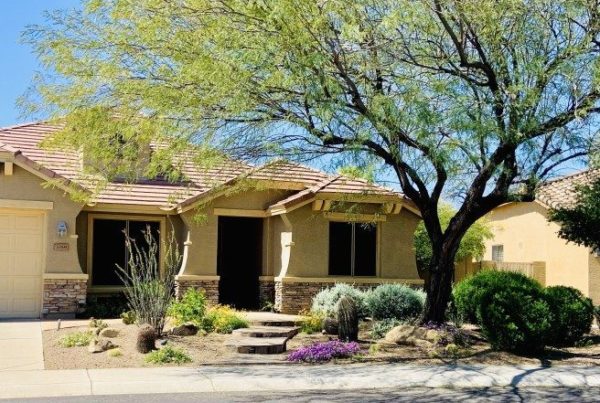

In the Southwest United States, a popular tree that you see, especially in the hotter regions, is the whimsical palo verde tree. It’s a unique tree that is known to turn heads with its array of yellow flowers and green limbs. The name itself means green (verde) stick (palo). As a native desert tree, by origin, this tree species is wonderfully drought-resistant, which makes it a common choice for water-wise landscaping in San Diego.
What issues do palo verde trees have?
Don’t let the palo verde’s whispy canopy fool you. Grab hold of one of its branches, and you’ll regret it. That’s because throughout the palo verde’s limbs are green thorns that blend in with the tree. But you can’t blame the tree. As with most desert plants, like cacti, they were designed with some form of spiky protection.
While the palo verde is covered in thorns, unless you are looking for a tree that children can climb, these thorns are not the biggest issue for property owners. Tree trimmers, on the other hand, hate them. Nonetheless, the most plaguing problem is the tree’s prolific nature. All of those beautiful yellow flowers that add to the tree’s aesthetic appeal also equal countless seed pods. Then before you know it, little palo seedlings begin to pop up throughout the property—not just under the canopy zone, but even a distance away from the tree.
Palo verde seedlings grow in hordes and they grow fast! When first spotted, they are typically easy to pull out, but if left alone for just a couple of weeks, they will soon be a foot long with a firmer grasp on the soil. Not only that, if they are not pulled out within days after sprouting, they will soon develop their thorns—which can make them a little tricker to pull out. Therefore, this is where the tree’s thorns become an issue. As an isolated concern, a tree with thorns is not a big deal. A cactus with its needles—not a big deal if you’re into that sort of thing. But a cactus that spawns hundreds of spiny cacti babies every year—an issue!
Each year, LC Tree Service removes quite a few palo verde trees from properties because the property owner is tired of battling the tree and its offspring from taking over the property.
FICUS TREE
The Root King

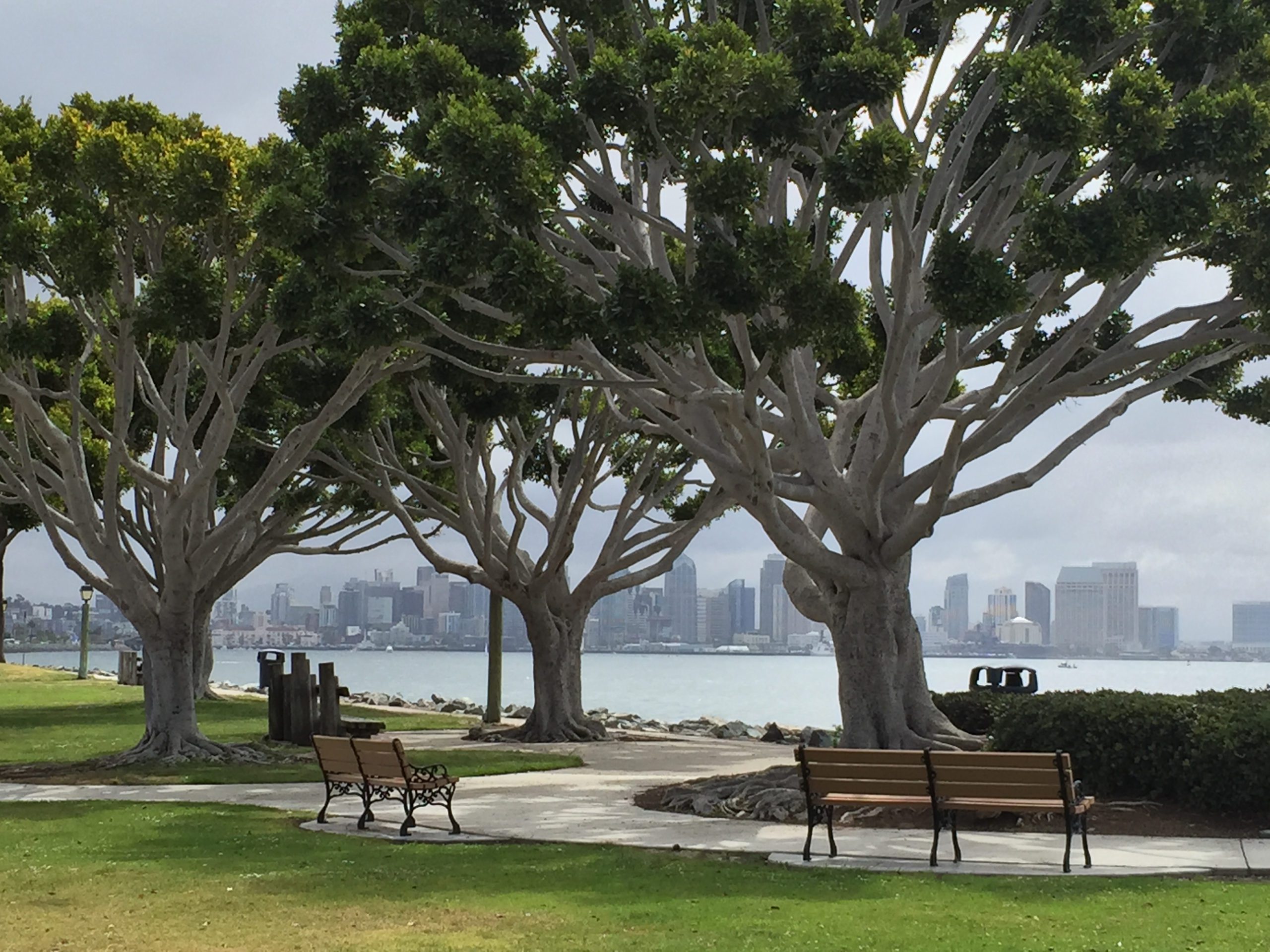
There are over 850 species are ficus trees, and several of them are a common sight in San Diego. However, the most common ficus species in our city is the Ficus benjamina—which also goes by the name weeping fig. But it is so popular in San Diego, that it trumps all of the other ficus species and is simply referred to as ficus.
Native to Asia and Australia, the Ficus benjamina is a common choice as an ornamental tree in San Diego landscapes because of its clean, majestic appearance and its perfectly green foliage. Its canopy develops large and dense, which makes this species a great shade tree.
What issues do ficus trees have?
The Ficus benjamina is a tree that is commonly seen as both an indoor and outdoor ornamental tree. It starts small and innocent-looking, even sometimes being sold less than a foot tall. It’s a hardy, low-maintenance tree, which is why it can do great indoors or outdoors. When bought at such a manageable size, it causes many people to misjudge its size potential. Therefore, when planted outdoors, it often gets planted too close to development, such as homes, buildings, curbs, and roads.
However, many years later, that same little tree has now grown to a mature 30-ft tree. The hardscape nearby has cracked and risen a few inches and the home’s closest wall also has a crack that gets bigger each year. What is going on?
When you look at the Ficus benjamina’s limbs, you’ll notice that they look really strong and stocky. Well, that’s because they are. That same nature also reflects the characteristics of its roots. The ficus’ mature root system will typically be visible above ground close to the base, but it also extends underground well beyond the reach of the canopy.
These roots have a notorious reputation for being destructive, which is why they have cost the City and property owners over a million dollars in maintenance and repairs. Nonetheless, this does not mean that the ficus tree needs to be completely ruled out as an ornamental tree. As long as adequate space is provided for its roots to grow, away from any development, it can grow without causing concern.
However, this is San Diego, and finding that much space for a ficus’ roots to grow can be a laughable notion for some. Therefore, installing root barrier is the answer. Root barriers are thick plastic linings that are placed underground to prevent tree roots from growing into an area. So with proper planning, the Ficus benjamina can still make a great outdoor shade tree. Without proper planning, then you’re in for a costly “treat” in the future.
Mexican Fan Palm
A Baja Touch
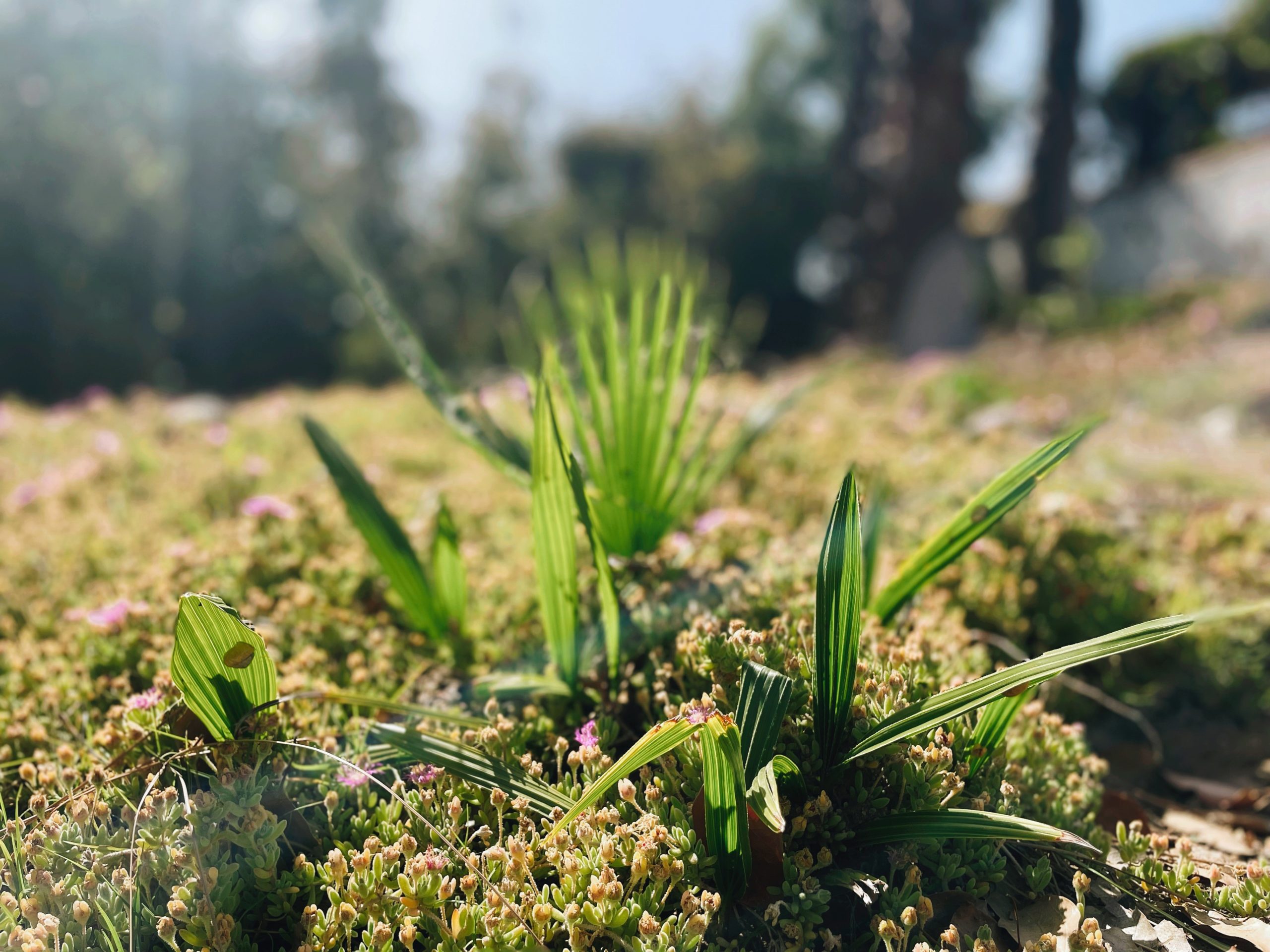

With its towering, slender trunk and distinctive fan-shaped fronds, the Mexican fan palm has become an iconic symbol for Southern California. As popular as it is, this palm species is not native to this region but comes from, as the name would imply, Mexico. In the 1930s, the Mexican fan palm was introduced to beautify the streets of Los Angeles during the Great Depression. It’s robust. It’s drought-tolerant. It adds a nice tropical baja touch to the landscape of San Diego. What’s not to love?
What issues do Mexican fan palms have?
The Mexican fan palm makes our list of the “San Diego Trees That Many Regret Planting”—not because it ruins foundations like the ficus tree or it refuses to go down without a fight like the tree-of-heaven—but because out of all of the common palms that San Diego has, it is the most high-maintenance.
Some palms, like the queen palm, are self-pruning and will naturally drop their dead fronds. Others stay an easily manageable size, like the pygmy palm. However, the Mexican fan palm does neither. If not trimmed off, the dead fronds will build up into an unsightly skirt that can run down nearly the entire length of the trunk. And this dead skirt makes the perfect home for undesired animals, such as mice and rats.
The other issue with Mexican fan palms that adds to their high maintenance is their ability to grow upwards of 100 feet, making them more difficult to trim and maintain. Tree trimmers either have to use a boom to reach the fronds, or if the crown is beyond the reach of the boom, then they have to climb the entire length. It’s not a task for the faint-hearted because the trunks are skinny and easily sway back and forth in the wind several feet.
The towering, lanky height of fan palms is mainly an issue for the tree trimmer. What about for the property owner? Not only do their heights make them more difficult to trim, but their messy nature requires them to be on a yearly trimming schedule. Their dead fronds need to be trimmed, as well as their seed pods that, if not trimmed off promptly, will rain down hundreds of seeds that easily take root when provided water. Property owners and gardeners are constantly plucking baby fan palms throughout the year.


